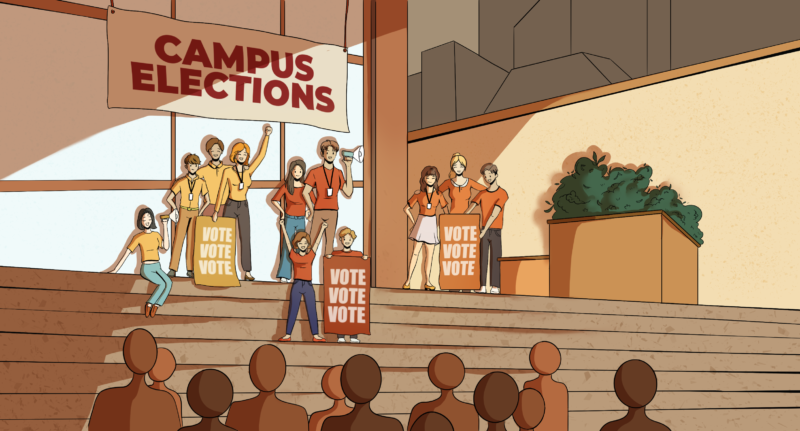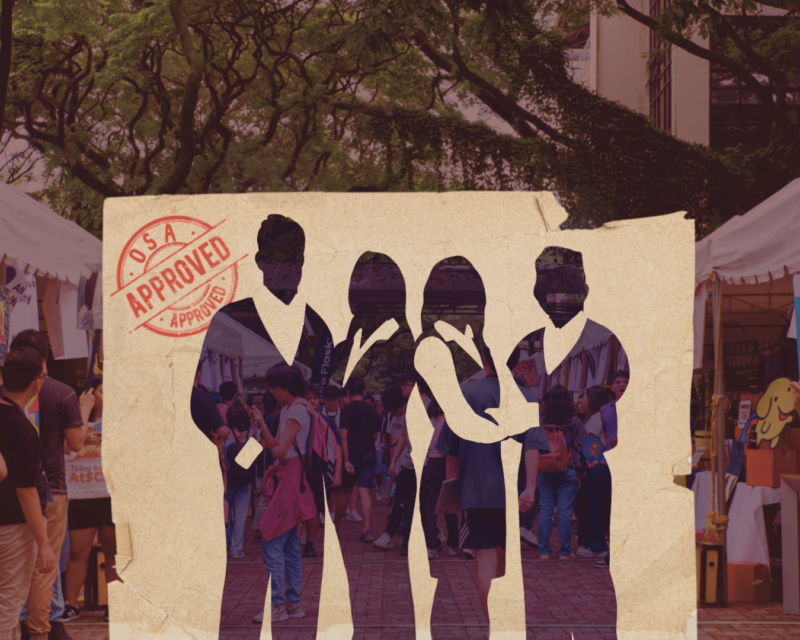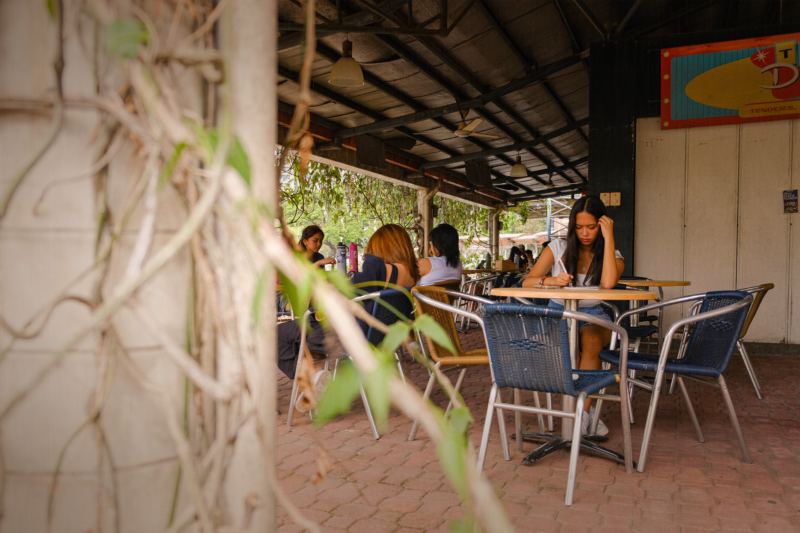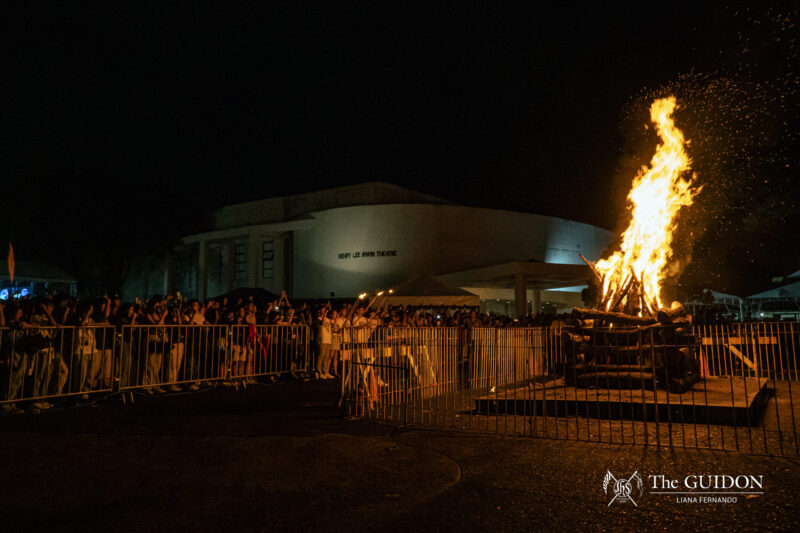TRAFFIC ISSUES continue to be an everyday struggle for anyone traversing Katipunan, which houses three large schools and accommodates an overwhelming number of vehicles daily. With the avenue’s car-centric infrastructure, its inadequate walkways and bicycle lanes endanger both pedestrians and cyclists alike.
This heavy reliance on cars is largely felt within the Ateneo despite its sprawling fields and lush forests. With seemingly endless complaints from the community, discussions on solving traffic congestion on campus amplify Ateneans’ unfaltering call for the University to further commit itself to inclusive and sustainable mobility.
Reaching destinations
In recent months, the Ateneo has initiated efforts to ameliorate the effects of car dependency, which include the availability of e-jeepneys and bike rack units. However, its road structures are still seen to mirror Metro Manila’s major thoroughfares.
Experiencing this inefficient transport network, Jericho Urquiola (4 AB DS) advocates for more active mobility options on campus. To further understand the struggles of his fellow commuters, he co-organized last year’s Mobility March—an initiative deemed as the Social Development Effort of the Year in the 2023 COA-M Awards. The project included conducting talks on active mobility, bicycle lessons, and walking tours.
Following this, Urquiola shares their decision to turn the initiative into an official organization called Blue Mobility (BlueMob). With the recent establishment of the advocate group, Urquiola hopes BlueMob can galvanize more Ateneans in championing inclusive and sustainable mobility.
Inclusive mobility is “by all, for all, and of all,” according to Development Studies professor Segundo Joaquin Romero Jr., PhD. This approach entails having all concerned stakeholders partake in diagnosing, designing, and deploying solutions. He adds that these interventions become sustainable when their effects on the present and future generations are considered.
“[Inclusive and sustainable mobility means] having all the factors in place to enable all sectors of society to reach their destinations,” Romero states.
To this end, the University professes an advocacy for “people-centric mobility.” After having 16 bike racks around campus since 2021, four more were donated to the Ateneo Senior High School (ASHS) last February. At the same time, it was confirmed that the number of operating e-jeeps on campus will be increased, along with the opening of more express lanes.
Additionally, the Department of Student Welfare and Services hosts a carpooling program, where car sticker rebates and select parking slots are made available to student participants.
These efforts, however, are perceptibly deficient in reducing congestion. Romero notes that there are likely twice as many registered cars as people due to the possibility of every individual registering about two to three cars.
For Urquiola, the inadequacy in addressing the excess of private vehicles can be attributed to a car-centric mindset among the decision-makers of the University’s mobility plans. Thus, he sees the need for community-led actions in claiming more campus spaces for people rather than cars.
Towards a greener path
Situated at the heart of a bustling metropolis, the Ateneo needs to tackle the challenges posed by the institution’s car-centric infrastructure to truly pursue pedestrian-friendly initiatives in the Ateneo.
Although using cars may have its advantages, ASHS Physical Education Associate Teacher Jarrel Agcaoili believes that walking and biking are the most economical ways to traverse the campus grounds. However, he notes that some students lack the necessary knowledge and skills in biking to even consider it a mode of transportation.
With this observation, Agcaoili led the establishment of the ASHS biking elective last January. Aside from teaching students the fundamentals of biking, the elective aims to also cover road etiquette, bike conditioning drills, and the positive environmental impact of cycling.
For Agcaoili, the elective offers students the opportunity to explore alternative modes of transportation inside and even outside the campus. It empowers them to make informed choices and contribute to sustainable mobility solutions.
Considering the initiative as their contribution to the Ateneo’s goal of becoming a Laudato Si’ University, Agcaoili hopes for more institutional support by increasing the number of bike racks on campus. For college students to further embrace the culture of active transportation, he also suggests expanding the elective to the Higher Education Cluster.
Meanwhile, Romero even proposes a monorail system that connects the University to other locations near Katipunan Avenue to eliminate the need for cars to enter the campus premises.
As these modes of transportation continue to be suggested, the need for infrastructural changes is further amplified. Agcaoili also finds it necessary to explore possible structural changes, such as widening bike lanes and walkways. He explains that doing so would encourage more Ateneans to choose active mobility options, as such changes would effectively accommodate cyclists and walking pedestrians.
“One can only say that the Ateneo is pedestrian-friendly if Ateneans themselves see that the best and first way to move around is not to use any cars,” Agcaoili says in a mix of English and Filipino.
Beyond and around the Ateneo
While re-designing campus infrastructure may potentially help in mitigating the University’s car-centric culture, the call for sustainable and inclusive mobility is not only confined to the campus. These sentiments reflect the need to push for the further development of people-centered and eco-ethical cities in the country.
As such, Romero asserts that to improve mobility within the Ateneo campus, changes also need to be made outside and around it. “Ateneo and outside—that is a problem that has not been solved. […] You need a paradigm shift, that it’s not only the internal environment of Ateneo that is the subject of modification, but also the surrounding area,” he says.
With this, Romero suggests the creation of a Bus Rapid Transit (BRT) system in Quezon City, similar to the Epifanio de los Santos Avenue (EDSA) Carousel. The BRT would ideally extend from EDSA all the way to Tandang Sora in Novaliches, with Katipunan located in the middle of these two endpoints. According to him, it would be a “very efficient way of moving people.”
Furthermore, Romero proposes a two-meter wide bike lane passing through Ateneo, Miriam College, and UP Town Center. Through this plan, he believes that people would be able to make their way toward Aurora Boulevard without having to worry about being overtaken by cars and motorcycles.
With Romero describing mobility as “basic to human society,” collaboration between the University and local authorities is crucial in addressing the traffic problem in Katipunan.
“There are so many things that can be done, but it requires human-centered design thinking, out-of-the-box thinking, systems thinking, [and] critical thinking. All of these things that we teach in Ateneo, we should practice when it comes to solving our real problems.” he says.
With the Ateneo taking pride in molding its students into compassionate, critically thinking nation-builders, the persisting traffic problem necessitates the institution to take the lead in crafting proactive mobility solutions both in and around the campus.







